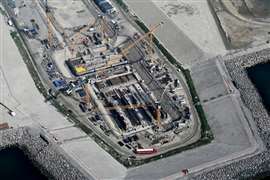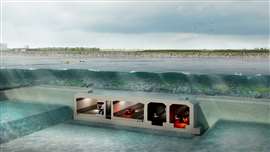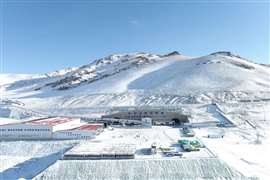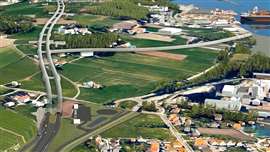5 of the world’s longest road tunnels under construction
17 November 2023
 The Fehmarnbelt tunnel portal at Rødbyhavn in Denmark, September 2023 (Image: Femern A/S)
The Fehmarnbelt tunnel portal at Rødbyhavn in Denmark, September 2023 (Image: Femern A/S)
Last month, The Construction Briefing went to see for itself the progress on the mammoth Fehmarnbelt under-sea tunnel between Denmark and Germany.
The €7.1 billion (US$7.5 billion) project (more details below) is well underway, with concrete sections required for the construction of the immersed tube tunnel now in production at a huge factory near the Danish entry to the tunnel at Rødbyhavn.
When complete, the tunnel will carry road traffic, as well as rail. Fehmarnbelt will be the world’s longest immersed tube tunnel when complete. But it isn’t the longest road tunnel currently under construction, although it does make the top five.
Here are the five longest road tunnels currently under construction around the world:
5) Daliangshan No.1 Tunnel, China
China Railway 18th Bureau is building the Daliangshan No.1 Tunnel as part of the 152km-long Sichuan Lexi Expressway in southwest China.
The 15.3km-long expressway tunnel, running through the Liangshan mountains, is reportedly the longest in the region.
Instead of blasting and drilling, the project is employing a tunnel boring machine (TBM) to bore the tunnel.
The rock surrounding the tunnel is mainly sandstone and silty mudstone, with the 7.9m-diameter TBM ‘Yuecheng Liangshan’ having to pass through difficult geological conditions, including faults in the rock and sections where there is an increased risk of water inrush.
The entire expressway project is due for completion in July 2025.
3=) Förbifart Stockholm
 The sun sets on the Förbifart Stockholm project (Image: Skanska)
The sun sets on the Förbifart Stockholm project (Image: Skanska)
Förbifart Stockholm is a series of underground tunnels under construction to bypass the Swedish capital of Stockholm.
A total of 18km of the new 21km stretch of the E4 motorway, which will connect north and south Stockholm consists of tunnels.
Construction on the project started in 2016 and is due to complete in 2031 at a cost of SEK 41.7 billion (US$3.8 billion).
Contractors have completed nearly 10km of rock tunnels, which run up to 70m deep, using the drill and blast method due to the mainly prevailing gneiss and granite rock in the area, secured by rock bolts and shotcrete.
Following blasting, shoring work and work to erect prefabricated tunnel walls will take place. Contractors are also set to lay pipes for cables and water and sewage systems and cast foundations for road signs and traffic monitoring cameras.
The contract to build the bypass is divided into six lots. Implenia won a deal to build the 3.6km long Johannelund tunnel, set to complete in 2024. AF Gruppen was appointed to build 6km of the E4 Förbifart Stockholm in 2020., including 6km of twin-tube tunnel and 7km of ramp tunnels. Other contractors including Skanksa, Veidekke Construction, and NCC also won contracts as part of the scheme.
3=) Fehmarnbelt
 Digital render of the Fehmarnbelt tunnel in cross section under the sea (Image: Femern A/S)
Digital render of the Fehmarnbelt tunnel in cross section under the sea (Image: Femern A/S)
Denmark’s 18km-long Fehmarnbelt, connecting Denmark with Germany, will be the longest immersed tube tunnel (IMT) in the world when the €7.1 billion (US$7.5 billion) project is completed.
It will also be the world’s longest combined road and rail tunnel.
The team behind the project favoured an IMT because it is more economically feasible than a bored tunnel and less risky than a bridge in an area with strong prevailing east-west winds.
The Fehmarnbelt tunnel will be nearly three times longer than the IMT section of the Hong Kong-Zuhai-Macau Fixed Link, currently the longest tube tunnel in the world.
Femern A/S, the company in charge has spent two years constructing a specially built harbour capable of receiving up to 80,000 tonnes of material each week. Meanwhile, the world’s largest tunnel factory will create tunnel sections at the Danish tunnel entrance at Rødbyhavn.
Fehmarn Belt Contractors (FBC), a joint venture between Boskalis and Van Oord has been conducting the main dredging and marine work.
The Fehmarn Link Contractors (FLC) consortium, which includes Vinci, BAM, Per Aarsleff, Wayss & Freytag Ingenieurbau and Max Bögl Stiftung, has been constructing the tunnel, the portal buildings, the casting factory and workers accommodation since January 2021.
Femern Systems Contractors (FSC) will equip the tunnel with lighting and safety systems, while Elecnor is building a large transformer station at Rødbyhavn to supply power to the tunnel’s railway.
The tunnel is expected to open in mid-2029. Read about the project in more detail here.
2) Tianshan Shengli Daban Tunnel, China
 Entrance to the Tianshan Shengli Tunnel (Image: CCCC)
Entrance to the Tianshan Shengli Tunnel (Image: CCCC)
China Communications Construction Company (CCCC) is building the 22.1km-long Tianshan Shengli Tunnel, which is the longest highway tunnel under construction in China.
The tunnel runs under the remote Tianshan Mountains at an altitude of 3,200 metres in China’s northwest Xinjiang Uygur Autonomous Region.
It is part of a 1,300km expressway connecting Xinjiang’s capital Urumqi to Yuli County.
Started in 2020, the six-year project involves building the tunnel in three sections, with four shafts in between them, using tunnel boring machines made by Chinese manufacturer Zhongjiao Tianhe.
1) Rogfast Tunnel, Norway
 Visualisation of the E03 Boknafjord tunnel on the west coast of Norway (image: Norwegian Public Roads Administration)
Visualisation of the E03 Boknafjord tunnel on the west coast of Norway (image: Norwegian Public Roads Administration)
The Rogfast Tunnel (also known as the Boknafjord Tunnel) in Norway will be the world’s longest and deepest subsea road tunnel, at a maximum depth of 392m below sea level and a total length of 26.7km.
The tunnel will link the municipalities of Randaberg near Stavanger and Bokn in Rogaland, carrying the E39 highway.
Construction work originally started in 2018 but then halted again in October 2019 due to cost overruns.
The Norwegian Public Roads Administration has split the project into three large tunnelling contracts. They cover the long tunnel segment running south from Bokn, the Kvitsøy tunnel segment, and the long tunnel segment running north from Randaberg.
So far, Skanska has won the E04 NOK 5 billion (US$460 million) deal to build the northern part of the tunnel. The work involves a twin segment with 18.5km of road in the tunnel and 2km above ground.
Meanwhile a joint venture between Implenia and Stangeland Maskin have won the E03 segment, consisting of an 8.6km-long, two-tube tunnel running from Harestad northwards to halfway between Tungenes and Kvitsøy. The JV’s contract is valued at NOK4 billion (US$370 million).
The Kvitsøy segment has not yet been awarded.
Skanska is expected to complete its worth in 2029 and the Implenia-Stangeland Maskin JV in 2030.
Challenges involved in the work, according to Statens Vegvesen the Norwegian Public Roads Administration, involve the long tunnel interfaces, challenging geological conditions, high water pressure and complex leakage prevention, and longitudinal ventilation.
STAY CONNECTED



Receive the information you need when you need it through our world-leading magazines, newsletters and daily briefings.
CONNECT WITH THE TEAM








